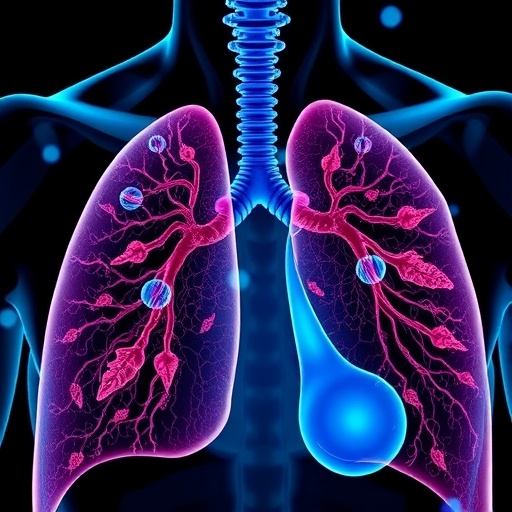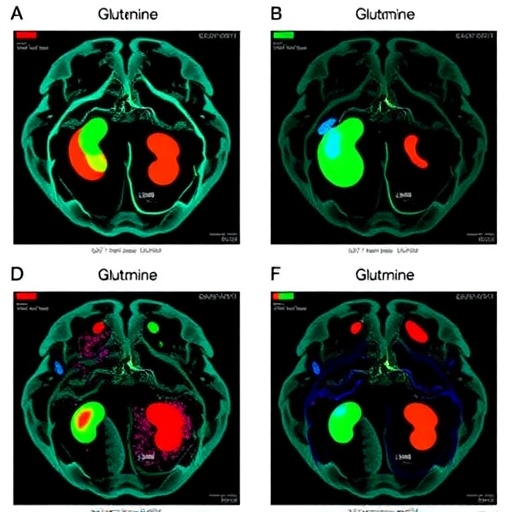Pulmonary fibrosis, a relentless and often fatal lung disease characterized by progressive scarring of lung tissue, continues to challenge clinicians and researchers alike. Recent breakthroughs have illuminated the profound role of amino acid metabolism in the pathogenesis and progression of this disorder, offering transformative insights into potential therapeutic avenues. Among these metabolic players, arginine has emerged as a central figure, orchestrating a multifaceted network that propels fibrotic remodeling through intricate biochemical pathways.
Central to pulmonary fibrosis is the remarkable upregulation of the arginine–proline metabolic axis, which fuels excessive extracellular matrix (ECM) deposition. Proline and its hydroxylated form constitute approximately one-third of the collagen amino acid composition, underscoring their critical involvement in fibrotic progression. The metabolic conversion of arginine to ornithine, followed by its transformation into proline via ornithine aminotransferase (OAT) and pyrroline-5-carboxylate reductase 1 (PYCR1), is markedly enhanced in fibrotic lungs. This enzymatic cascade not only facilitates collagen synthesis but also intertwines with canonical fibrotic signaling pathways, notably transforming growth factor-beta 1 (TGF-β1).
Intriguingly, OAT serves as a pivotal node linking metabolic flux to fibrogenic signaling. Beyond its enzymatic role, OAT potentiates TGF-β1 activation, amplifying both Smad-dependent and alternative signaling cascades that sustain fibroblast activation and matrix production. This enzyme further induces proline dehydrogenase (PRODH), catalyzing mitochondrial reactive oxygen species (ROS) generation, which reinforces fibrotic signaling. PYCR1, often complexed with the cytoskeletal adaptor kindlin-2, facilitates mitochondrial proline biosynthesis and stabilizes collagen assembly. Both genetic disruption of kindlin-2 and the anti-fibrotic agent pirfenidone mitigate PYCR1 activity, proline synthesis, and fibrosis severity, highlighting the therapeutic potential of targeting this axis.
Arginine transport into cells is an additional regulatory checkpoint in fibrogenesis. The cationic amino acid transporter-2 (CAT-2) mediates the uptake of arginine, which is essential for arginase activity and subsequent collagen production, specifically within macrophages. Arginase-1 predominantly expresses in macrophages, while arginase-2 localizes more broadly, including myofibroblasts. Notably, arginase-2 colocalizes with heat shock protein 47 (Hsp47), a chaperone integral to collagen maturation, further cementing the relationship between arginine metabolism and ECM synthesis. Pharmacological inhibition of arginase suppresses TGF-β1-induced collagen deposition in both human and murine fibrotic models, emphasizing its candidacy as a therapeutic target.
Paradoxically, arginine also gives rise to polyamines, such as spermidine and creatine, which exert anti-fibrotic effects through mechanisms involving oxidative stress mitigation and autophagy induction. Levels of these polyamines are conspicuously diminished in fibrotic lungs, and their supplementation attenuates disease severity by counteracting cellular stress. This duality in arginine metabolism—fueling fibrosis via proline production while simultaneously generating anti-fibrotic metabolites—reflects the complex metabolic reprogramming within fibrotic tissues.
Complementing the arginine–proline axis, the arginine–nitric oxide synthase (NOS) pathway plays a nuanced and context-dependent role in pulmonary fibrosis. Nitric oxide (NO), produced by NOS enzymes using L-arginine as a substrate, displays dichotomous effects on fibrosis. Inducible NOS (iNOS or NOS2), often upregulated in idiopathic pulmonary fibrosis (IPF), exacerbates inflammation and fibrosis through activation of NF-κB and the NLRP3 inflammasome. Conversely, endothelial NOS (eNOS)-derived NO appears protective by preserving vascular homeostasis and limiting fibrotic injury. This dichotomy suggests that cell-type specific NOS activity dictates divergent outcomes in fibrosis pathogenesis.
A key regulator of NOS function is the enzyme dimethylarginine dimethylaminohydrolase (DDAH), which degrades the endogenous NOS inhibitor asymmetric dimethylarginine (ADMA). Upregulated DDAH in IPF lowers ADMA levels, thereby potentiating NOS2 activity and NO production, which contributes to fibrotic signaling. Importantly, pharmacological inhibition of DDAH reduces TGF-β/Smad-dependent collagen synthesis and impairs alveolar epithelial cell proliferation, indicating its role as a promising therapeutic target.
Expanding beyond arginine metabolism, glutamine emerges as a critical amino acid modulating pulmonary fibrosis. Glutaminase 1 (GLS1) catalyzes the conversion of glutamine to glutamate, a fundamental step upregulated by TGF-β1 in fibrotic fibroblasts. Glutamate fuels the biosynthesis of proline and alanine, vital substrates for collagen production, and contributes to the generation of α-ketoglutarate (α-KG), an activator of the mechanistic target of rapamycin complex 1 (mTORC1). mTORC1 signaling promotes proline hydroxylation and collagen stabilization, thereby augmenting ECM accumulation.
The regulatory network governing GLS1 expression is multifaceted, involving SMAD-dependent and PI3K/mTORC2/PDGFR pathways, and is modulated by epigenetic factors such as Sirtuin-7 and FOXO4. Loss of caveolin-1 (CAV1), a negative regulator of YAP1 activity in fibroblasts, further enhances GLS1 expression in fibrotic lungs. Pharmacological inhibition of GLS1 curtails fibroblast proliferation and collagen synthesis, yet compensatory metabolic pathways exist, underscoring the need for comprehensive strategies targeting glutamine metabolism.
Glycine, constituting one-third of collagen amino acids, represents another indispensable metabolite driving fibrotic ECM biosynthesis. The serine–glycine biosynthesis pathway is profoundly enhanced in pulmonary fibrosis, orchestrated by TGF-β-mediated upregulation of enzymes including PHGDH, PSAT1, PSPH, and SHMT1/2. This metabolic remodeling is supported by increased glycolytic flux, generating 3-phosphoglycerate as a precursor for glycine synthesis. The transcription factor ATF4, activated downstream of TGF-β and mTORC1 signaling, governs serine–glycine biosynthetic enzymes and amino acid transporters, establishing a metabolic milieu favoring ECM deposition.
Tryptophan metabolism exerts a paradoxical influence on pulmonary fibrosis, with metabolites exhibiting both pro- and anti-fibrotic activities. Elevated tryptophan and its derivative serotonin foster fibrotic signaling via enhancement of TGF-β1 pathways and promotion of inflammation. Conversely, indole-3-acetic acid (IAA), produced by gut microbiota, and the derivative 5-methoxytryptophan (5-MTP) exhibit anti-fibrotic properties by inhibiting PI3K/AKT/mTOR signaling and fibroblast activation. The kynurenine pathway (KP) further complicates this landscape: kynurenine activates the aryl hydrocarbon receptor (AhR), suppressing fibroblast activation and migration, yet under certain conditions can exacerbate IL-17A-dependent inflammation, highlighting the nuanced immunometabolic interplay in fibrosis.
Oxidative stress management in fibrotic lungs is intricately linked to the glutathione (GSH) system, synthesized from glutamate, cysteine, and glycine. In IPF, GSH levels are notably depleted, attributed to suppression of glutamate–cysteine ligase (GCL) and GSH synthetase activities via TGF-β1 signaling and post-translational modifications. Reduced GSH exacerbates oxidative damage, promotes fibroblast proliferation, and augments ECM deposition. Conversely, increased extracellular cysteine/cystine redox potential potentiates fibrotic signaling, demonstrating the delicate balance between antioxidant defenses and redox-mediated fibroblast activation. Genetic models highlight the paradox where impairment of GSH degradation enzymes attenuates fibrosis by limiting cysteine availability and associated matrix remodeling.
Methionine metabolism has also been implicated in IPF pathogenesis. Elevated methionine transport into the lungs, alongside upregulated methionine aminopeptidase 2 (MetAP2), promotes fibroblast proliferation and collagen deposition. Pharmacological blockade of MetAP2 hinders these fibrogenic processes, positioning this enzyme as a novel therapeutic target. Intriguingly, deficiency of D-amino acid oxidase (DAO), responsible for degrading D-amino acids, predisposes to aggravated fibrosis, possibly through disrupted metabolic and immune signaling. DAO also modulates alveolar epithelial cell senescence, influencing epithelial repair and fibrosis.
The complexity of amino acid metabolism in pulmonary fibrosis underscores a finely tuned network where metabolic fluxes converge with canonical signaling pathways and epigenetic modifications. The intertwined roles of arginine, glutamine, glycine, tryptophan, cysteine, and methionine reflect a systems-level reprogramming that sustains fibroblast activation, ECM overproduction, and oxidative stress. Therapeutic strategies aimed at modulating key metabolic nodes—such as arginase activity, GLS1, PHGDH, DDAH, and PRMTs—hold significant promise for transforming IPF management. Emerging data also advocate for interventions targeting amino acid transporters and post-translational modifying enzymes that regulate protein function and gene expression in fibrosis.
Future research must dissect the cell type-specific contributions and temporal dynamics of these metabolic pathways to balance efficacy with preservation of essential immune and vascular functions. Integrating metabolic profiling with genetic and pharmacologic tools will further unravel the metabolic vulnerabilities exploitable in pulmonary fibrosis. As our understanding advances, metabolically targeted therapies are poised to complement or surpass existing anti-fibrotic agents, potentially altering the bleak prognosis of this formidable disease.
Subject of Research: Metabolic dysregulation and amino acid metabolism in pulmonary fibrosis pathogenesis and therapy.
Article Title: Metabolic dysregulation in pulmonary fibrosis: insights into amino acid contributions and therapeutic potential.
Article References:
Zheng, H., Zhang, L., Wang, C. et al. Metabolic dysregulation in pulmonary fibrosis: insights into amino acid contributions and therapeutic potential. Cell Death Discov. 11, 411 (2025). https://doi.org/10.1038/s41420-025-02715-2
Image Credits: AI Generated
DOI: https://doi.org/10.1038/s41420-025-02715-2
Tags: arginine and proline metabolic axiscollagen synthesis in lung diseaseextracellular matrix deposition in fibrosisfibrogenic signaling pathwaysfibrotic remodeling biochemical pathwaysmetabolic dysfunction in lung disordersornithine aminotransferase in fibrosispulmonary fibrosis and amino acid metabolismrole of enzymes in fibrosis progressionTGF-β1 signaling in pulmonary fibrosistherapeutic insights for lung diseasesunderstanding pulmonary fibrosis pathogenesis





